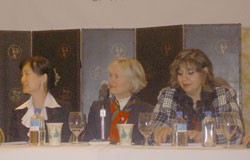
Until recently, the Egyptian judiciary was strictly a male preserve. In 2003, with the direct appointment of the first female judge, Dr. Tahani El Gebali, to the constitutional court, Egypt had only one female out of approximately 9,300 judges.
Recognizing the need to diversify the judiciary, USAID focused on integrating women as part of its efforts to improve the efficiency and transparency of Egypt’s civil and commercial courts.
Shortly after participating on a study tour to Morocco (where women have been part of the judiciary since 1961), senior officials of Egypt’s Ministry of Justice developed a plan to integrate women into the judiciary, beginning with the lateral transfer of female administrative prosecutors. Based on transparently administered written and oral assessments of the 124 applicants, the ministry selected 30 women, who were sworn in as members of the judiciary and assigned to the courts of first instance in Alexandria, Cairo and Giza. These female judges then participated in a training plan that included a number of in-country activities as well as overseas study tours.
“The amount of support we have received as the first [female] judges to be appointed in Egypt was enormous,” said chief judge Cherine Wechahy, of the Giza court of first instance. She said, “Our study tour gave us a great opportunity to learn a lot of new concepts and ideas in court management and administration. Learning about mediation, which is used in most American courts, and its benefits in terms of decreasing the number of cases filed was one of the greatest achievements.”
Chief Judge Hanan Dahroug, of the Cairo Court of First Instance, said the “exchange of ideas and knowledge about the different judicial systems and the latest judicial management and administration developments helped us very much in developing our courts and its administration.” “In addition, we learned more from our discussions with American judges about the importance of the judge’s role not only in sitting on the bench but more importantly his or her role in civil society by raising awareness among citizens about their rights and their role in society,” she said.







Comment
Make a general inquiry or suggest an improvement.